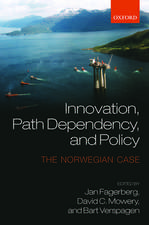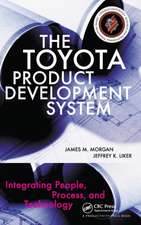Collaborative Communities of Firms: Purpose, Process, and Design: Information and Organization Design Series, cartea 9
Editat de Anne Bøllingtoft, Lex Donaldson, George P. Huber, Dorthe Døjbak Håkonsson, Charles C. Snowen Limba Engleză Paperback – 25 ian 2014
Drawing from the Fourth International Workshop on Organization Design, and featuring contributions from an international array of specialists, this volume focuses on the expansion beyond the boundaries of the single firm and multi-firm networks, to include, for example, community-based organization designs. A community is a connected set of firms; the connections can take on many different dimensions. For organization design theory, community-based organizations have many implications. For one, organization design theory has to identify and describe designs that enhance collaborative behavior among firms without restricting the ability of the individual firm to continue to compete within its own marketplace. Moreover, organization design theory also has to identify and describe information processing strategies and designs that allow the continuous generation, sharing, and application of existing information and knowledge.
The development of effective collaborative community designs is critically important to the global economy because, increasingly, our future depends on pursuing shared goals and sustainably developing our global commons. Ideally, theideas and findings in this book will contribute to increased attention to new organization designs capable of meeting 21st-century opportunities and challenges.
| Toate formatele și edițiile | Preț | Express |
|---|---|---|
| Paperback (1) | 633.68 lei 6-8 săpt. | |
| Springer – 25 ian 2014 | 633.68 lei 6-8 săpt. | |
| Hardback (1) | 639.25 lei 6-8 săpt. | |
| Springer – 22 noi 2011 | 639.25 lei 6-8 săpt. |
Preț: 633.68 lei
Preț vechi: 745.50 lei
-15% Nou
Puncte Express: 951
Preț estimativ în valută:
121.26€ • 126.86$ • 100.73£
121.26€ • 126.86$ • 100.73£
Carte tipărită la comandă
Livrare economică 02-16 aprilie
Preluare comenzi: 021 569.72.76
Specificații
ISBN-13: 9781489991119
ISBN-10: 1489991115
Pagini: 156
Ilustrații: VIII, 148 p.
Dimensiuni: 155 x 235 x 8 mm
Greutate: 0.23 kg
Ediția:2012
Editura: Springer
Colecția Springer
Seria Information and Organization Design Series
Locul publicării:New York, NY, United States
ISBN-10: 1489991115
Pagini: 156
Ilustrații: VIII, 148 p.
Dimensiuni: 155 x 235 x 8 mm
Greutate: 0.23 kg
Ediția:2012
Editura: Springer
Colecția Springer
Seria Information and Organization Design Series
Locul publicării:New York, NY, United States
Public țintă
ResearchTextul de pe ultima copertă
Faced with the ever-accelerating pace of technological change and the restructuring of markets, many firms have been questioning the appropriateness of their own organizational structure and effectiveness. Consequently, we have witnessed much organizational experimentation and the development of new forms of organizing over the last decade. Firms are more dependent than ever on the need for continuous and radical innovations – and often innovations that go beyond their existing businesses. This challenges firms in terms of knowledge and idea sharing, and often necessitates the need to expand beyond the boundaries of the single firm for multi-party collaboration to meet serious challenges and develop creative solutions.
Drawing from the Fourth International Workshop on Organization Design, and featuring contributions from an international array of specialists, this volume focuses on the expansion beyond the boundaries of the single firm and multi-firm networks, to include, for example, community-based organization designs. A community is a connected set of firms; the connections can take on many different dimensions. For organization design theory, community-based organizations have many implications. For one, organization design theory has to identify and describe designs that enhance collaborative behavior among firms without restricting the ability of the individual firm to continue to compete within its own marketplace. Moreover, organization design theory also has to identify and describe information processing strategies and designs that allow the continuous generation, sharing, and application of existing information and knowledge.
The development of effective collaborative community designs is critically important to the global economy because, increasingly, our future depends on pursuing shared goals and sustainably developing our global commons. Ideally, theideas and findings in this book will contribute to increased attention to new organization designs capable of meeting 21st-century opportunities and challenges.
Drawing from the Fourth International Workshop on Organization Design, and featuring contributions from an international array of specialists, this volume focuses on the expansion beyond the boundaries of the single firm and multi-firm networks, to include, for example, community-based organization designs. A community is a connected set of firms; the connections can take on many different dimensions. For organization design theory, community-based organizations have many implications. For one, organization design theory has to identify and describe designs that enhance collaborative behavior among firms without restricting the ability of the individual firm to continue to compete within its own marketplace. Moreover, organization design theory also has to identify and describe information processing strategies and designs that allow the continuous generation, sharing, and application of existing information and knowledge.
The development of effective collaborative community designs is critically important to the global economy because, increasingly, our future depends on pursuing shared goals and sustainably developing our global commons. Ideally, theideas and findings in this book will contribute to increased attention to new organization designs capable of meeting 21st-century opportunities and challenges.
Caracteristici
Fourth in a series of books emerging from ongoing workshops on the state of the art in organization design International coverage, with authors from the U.S., Europe, and Australia Includes examples of innovative practices in different types of organizations and networks of organizations Includes supplementary material: sn.pub/extras


























